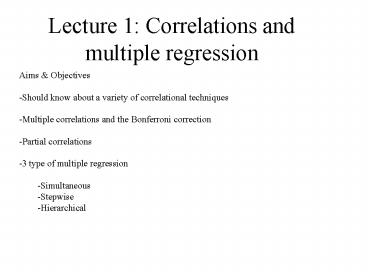Lecture 1: Correlations and multiple regression - PowerPoint PPT Presentation
1 / 23
Title:
Lecture 1: Correlations and multiple regression
Description:
Should know about a variety of correlational techniques ... Biserial (Interval & dichotomised) Point-biserial (interval & true dichotomy) ... – PowerPoint PPT presentation
Number of Views:127
Avg rating:3.0/5.0
Title: Lecture 1: Correlations and multiple regression
1
Lecture 1 Correlations and multiple regression
- Aims Objectives
- Should know about a variety of correlational
techniques - Multiple correlations and the Bonferroni
correction - Partial correlations
- 3 type of multiple regression
- Simultaneous
- Stepwise
- Hierarchical
2
Questions techniques
- What is the association between a set of
variables - This takes a number of multi-variate forms
- Associations between a number of variables
- (multiple-correlations)
- Associations between 1 variable (DV) and many
variables (IVs) MODEL BUILDING - regression and partial correlations
- Associations between 1 set of variables and
another set of variables - canonical correlations
3
Correlations
1
High
Vary between 1 and 1
-1
Low
High
Low
4
Types of correlation
- Pearsons (Interval and ratio data)
- Spearmans (Ordinal data)
- Phi (both true dichotomies)
- Tau (rating)
- Biserial (Interval dichotomised)
- Point-biserial (interval true dichotomy)
5
Factors affecting correlations
- Outliers
- Homoscedecence
- Restriction of range
- Multi-collinearity
- Singularity
6
Outliers
Outlier or influential point Cooks distance of 1
or greater
7
Homoscedasticity
When the variability of scores (errors) in one
continuous variable is the same in a second
variable
At group level data this is Termed homogeneity
of variance
8
Heteroscedasicity
One variable is skew or the relationship is
non-linear
9
Singularity Multicollinearity
- Singularity
- when variables are redundant, one variable is a
combination of two or more other variables. - Multi-collinearity
- when variables are highly correlated (.90). For
example two measures of IQ - Problems
- Logical Dont want to measure the same thing
twice. - Statistical Singularity prevents matrix
inversion (division) as determinants zero, for
multi-collinearity determinant zero to many
decimal places - Screening
- Bivariate correlations
- Examine SMC large problems
- Tolerance (1 SMC)
- Solutions
- Composite score
- Remove 1 variable
10
IQ Multi-collinearity Singularity
Multicolinear
IQ2
IQ1
Singular
Memory
Maths
Verbal
Spatial
Total IQ is singular with its own sub-scales
(total is a function of combining subscales One
total IQ test (MD5) is multicolinear with another
(MAT)
11
Multiple correlations
12
Partial correlations
Partial r Neuroticism (N) once the overlap of
stress with N and the Stress with Depression is
removed Semi-partial r for N once overlap of
Stress with N is removed
Neuroticism
Depression
IV1
N
a
DV
d
c
Dep
b
S
IV2
Stress
13
Bonferroni correction
- With multiple r matrix R or many (k) IVs in
regression analysis then the possibility of
chance effects increases - Correct the a level (0.05/N)
- Correct for the number of effects expected by
chance a N (0.05 N)
14
Multiple regression
Y
B
(slope)
A
(intercept)
X
15
Regression assumptions
- NIVs ratio
- Assume medium effect size
- for Multiple Correlations N gt 50 8m (m N of
IVs) - For simple linear regression N gt 104 m
- (8/f2) (m 1). Where f2 ES .10, .15
- or f2 .35
- f2 R2/(1 R2) for a more accurate estimate
- Stepwise 401
- Outlier Cook distance
- Singularity-Multi-collinearity SMCs
- Normality residual plots
16
Types of regression
- Simultaneous (Standard)
- No theory and enter all IV in one block
- Stepwise
- No theory. Allows the computer to choose on
statistical ground the best sub-set of IVs to fit
the equations. Capitalises on chance effects - Hierarchical (sequential)
- Theory driven. A-priori sequence of entry.
17
Types of regression An example
Simultaneous Age Gender Stress N Control
Stepwise Age Control
Hierarchical Step 1 Age Gender Step
2 Stress N Control
18
Venn Diagrams
Age
Sex
Depression
a
b
c
d
e
Neuroticism
f
g
Stress
19
Standard Regression
Age
Sex
Depression
a
c
e
Neuroticism
g
Stress
20
Hierarchical
Step 1
Age
Sex
Depression
a
b
c
d
e
Neuroticism
f
g
Step 2
Stress
21
Stepwise
Age
Sex
Depression
a
b
c
d
e
Neuroticism
f
g
Stress
22
Stepwise
Age
Sex
Depression
a
b
c
d
e
Neuroticism
f
g
Stress
23
Statistical terms
- B un-standardized Beta
- Beta standardized (-1 to 1)
- T-test Is the beta significant?
- R2 0-1 (amount of variance accounted for)
- DR2 Change in from one block to the next
- DF is the change in R significant?
- F Is the equation significant?

